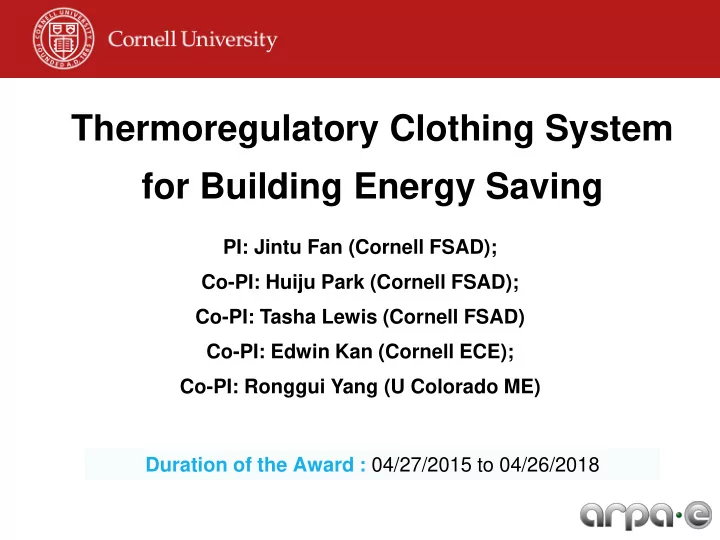

Thermoregulatory Clothing System for Building Energy Saving PI: Jintu Fan (Cornell FSAD); Co-PI: Huiju Park (Cornell FSAD); Co-PI: Tasha Lewis (Cornell FSAD) Co-PI: Edwin Kan (Cornell ECE); Co-PI: Ronggui Yang (U Colorado ME) Duration of the Award : 04/27/2015 to 04/26/2018
Description of Technology An air-conditioning garment system consisting of an undergarment fitted with detachable micro-tubes and an electro-mechanical heating/cooling device (EMD), providing next-to-skin cooling/warm air for thermoregulation. • Breathable undershirt embedded with microtubes. • Supplying of next-to-skin moving air for thermoregulation. • Sensing of skin temperature and wireless communication using fabric antenna • Intelligent control of microclimate. • Efficient and compact thermoelectric energy conversion unit.
Value Proposition and Uniqueness • Improved personal comfort, particularly in extreme conditions. • HVAC energy saving for indoor occupants. • Effective cooling/heating function (up to 27 watts cooling and 18 watts heating) with COP>1. • Portable personal air-conditioning. • Machine washable of the undergarment after detaching the micro- tubes and the electro-mechanical heating/cooling device (EMD). • Little effect on choice of outer wear and appearance. • Affordable (~$10 for undergarment, ~$200 for the EMD unit which can be used for 3 to 5 years).
Key Challenges and Achievements • Pressure drop in the micro-tubes. • Seamless integration with the clothing system.
Key Challenges and Achievements • Pressure drop in the micro-tubes. • Seamless integration with the clothing system.
Key Challenges and Achievements • Compactness and efficiency of thermoelectric energy conversion unit. 16 50 14 Modified version TECU 45 st TECU prototype Cooling Power (W) 1 40 Heating Power (W) 12 35 10 30 25 8 20 st TECU prototype 1 15 6 Modified TECU-1 10 Modified TECU-2 5 4 Weight: 430 g 0 0.00 0.0 0.5 1.0 1.5 2.0 2.5 3.0 Dimension: 14cm × 8cm × 4cm 0.0 0.5 1.0 1.5 2.0 2.5 3.0 Current (A) Current (A) • Accuracy in next-to-skin sensing and optimization in wireless communication & control. RFID reader passive sensor tag on undergarment
Market Discovery & Penetration First respondants Police Elderly care: ~$300B Equine Air force Infantry
Potential Collaboration with DELTA Community • Thermal manikin testing • Wireless passive tag sensing and communication technology • Apparel design and manufacturing • Market discovery and commercialization
Recommend
More recommend